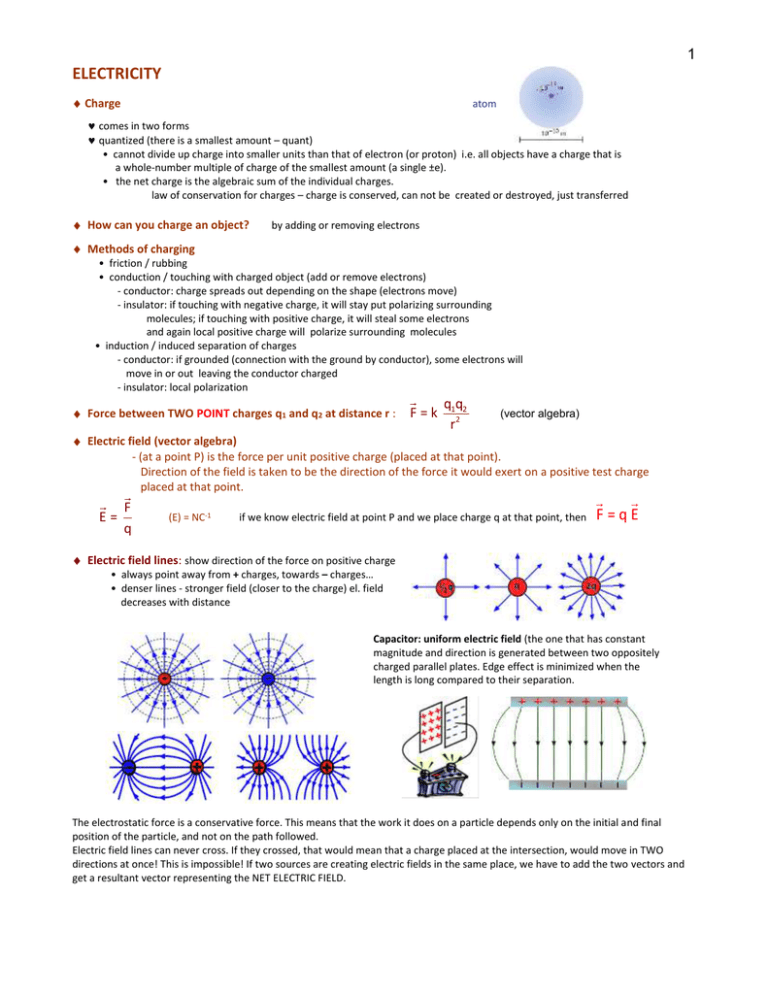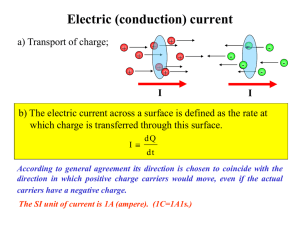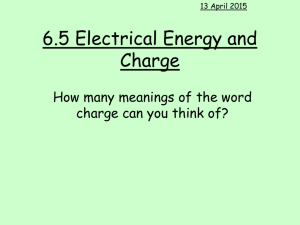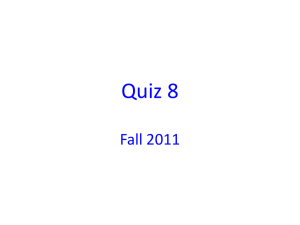1 - Uplift Education
advertisement

1 ELECTRICITY Charge atom comes in two forms quantized (there is a smallest amount – quant) • cannot divide up charge into smaller units than that of electron (or proton) i.e. all objects have a charge that is a whole-number multiple of charge of the smallest amount (a single ±e). • the net charge is the algebraic sum of the individual charges. law of conservation for charges – charge is conserved, can not be created or destroyed, just transferred How can you charge an object? by adding or removing electrons Methods of charging • friction / rubbing • conduction / touching with charged object (add or remove electrons) - conductor: charge spreads out depending on the shape (electrons move) - insulator: if touching with negative charge, it will stay put polarizing surrounding molecules; if touching with positive charge, it will steal some electrons and again local positive charge will polarize surrounding molecules • induction / induced separation of charges - conductor: if grounded (connection with the ground by conductor), some electrons will move in or out leaving the conductor charged - insulator: local polarization Force between TWO POINT charges q1 and q2 at distance r : F=k q1q2 r2 (vector algebra) Electric field (vector algebra) - (at a point P) is the force per unit positive charge (placed at that point). Direction of the field is taken to be the direction of the force it would exert on a positive test charge placed at that point. E= F q (E) = NC-1 if we know electric field at point P and we place charge q at that point, then F=qE Electric field lines: show direction of the force on positive charge • always point away from + charges, towards – charges… • denser lines - stronger field (closer to the charge) el. field decreases with distance Capacitor: uniform electric field (the one that has constant magnitude and direction is generated between two oppositely charged parallel plates. Edge effect is minimized when the length is long compared to their separation. The electrostatic force is a conservative force. This means that the work it does on a particle depends only on the initial and final position of the particle, and not on the path followed. Electric field lines can never cross. If they crossed, that would mean that a charge placed at the intersection, would move in TWO directions at once! This is impossible! If two sources are creating electric fields in the same place, we have to add the two vectors and get a resultant vector representing the NET ELECTRIC FIELD. 2 El. field of a point charge Q at the distance r from it. E=k Q r2 El. field outside a charged sphere (evenly distributed charge Q over surface) at distance r from its center is the same as if the charge q is concentrated at the center of the sphere: E=k E=k Q r2 Q El. field between two oppositely charged plates is uniform (const. magnitude & direction) r>R E = ΔV/d NC-1 = Vm-1 r=R R2 E=0 r<R Electrostatic equilibrium: When there is no net motion of charge within a conductor, the conductor is in electrostatic equilibrium. (If you take a look at any cross-section of that conductor, there will be equal number of electrons passing in both direction at any time.) A conductor in electrostatic equilibrium has the following properties: The electric field is zero everywhere inside the conductor. If an isolated conductor carries an excess of charge, the charge resides on its surface. The electric field just outside a charged conductor is perpendicular to the surface of the conductor. On an irregularly shaped conductor, the surface charge density is greatest at locations where the radius of curvature of the surface is smallest (sharp points). Electrical potential energy, U (U) = 1J (Joule) Work done by external force is required to push charge against an E-field between points A and B. This work done on the charge changes its potential energy to a higher value, and amount of work which is done is equal to the change in the potential energy (it is stored as electrical PE). Definition: Electric potential energy is the energy that a charge has as a result of its position in an electric field. It depends on the amount of charge moved. The quantity that depends only on positions A and B and not on the amount of charge is energy difference per unit charge. Electrical potential difference, ΔV Definition: The potential difference between two points in an electric field is the energy difference per unit charge moved or the work done per unit charge in bringing it from one point to another. ΔV = ΔU q 1J = 1V 1C Equivalent definition: The potential difference between two points in an electric field is the work done per unit charge as a charge is moved between these two points. ΔV = W q Points (A and B) have potential difference, charge placed there has electric potential energy difference. Both electric potential energy and electric potential are scalars. Positive charge accelerates from higher potential (+) to lower potential (–). Negative charge accelerates from lower (–) to higher potential (+). 3 Uniform electric field, E If a positive charge q is released at point A, force F = qE will accelerate it in the direction of the field toward point B. Work done on charge by force F along displacement d is converted into kinetic energy. W = Fd = qEd = ½ mv2 (remember: const E, const. F so W = Fd) Remember, this is not external force acting against electric field increasing potential energy, but the force due to electric field. Charge is losing potential energy: W = ΔU ΔV = ∆U/q = Ed ( E = F/q & E = ΔV/d, so NC-1 = Vm-1 ) An electron volt is the amount of energy/work it takes to move an electron through a potential difference of 1 volt. 1 eV = 1.6x10-19 J ( W = q ΔV = (1e)(1V) = 1eV = (1.6x10-19 C) (1V) = 1.6x10-19 J) Electric current I DEF: is the rate at which charge flows past a given cross-section. is the amount of charge q that passes a given point in a wire in a time t I = q/t 1A = DEF of Ampere: 1 A is defined as that current flowing in each of two infinitely-long parallel wires of negligible cross-sectional area separated by a distance of one metre in a vacuum that results in a force of exactly 2 x 10-7 N per metre of length of each wire. 1C 1s F 0 I1I2 L 2 d Carriers of the current Solids – electrons in metals and graphite, and holes in semiconductors Liquids – positive and negative ions in molten and aqueous electrolytes Gases – electrons and positive ions stripped from gaseous molecules by large potential differences. Drift velocity/speed Free/conducting electrons move randomly, passing on average the same number in both directions through any cross section in a resistor, so there is no net flow in any direction. But under the influence of an electric field in the wire, electrons are accelerated along their path reaching enormous speeds of about 106 m/s. They collide with positive ions of crystal lattice increasing their amplitude of vibrations generating heat that causes the temperature of the metal to increase. After transferring their kinetic energy, they are again accelerated because of the electric field, until the next collision occurs. Due to the collisions with positive ions of crystal lattice, hence changing direction, it is estimated that the drift velocity is only a small fraction of a metre each second (about 10 -4 m/s). DEF: The electrons go one way but the current flows the opposite to the direction that the electrons travel. That’s convention. Ohm’s law: DEF: current through resistor is proportional to potential difference on the resistor if the temperature of a resistor is constant (the resistance of a conductor is constant). Math definition: I= V R if resistance R is constant/ temperature is constant I – current V – potential difference across R !!!!!!! the source of electrons is wire itself – free electrons in it !!!!!! 4 Resistance of a wire when the temperature is kept constant R L A ρ is the resistivity of the material of the resistor; L – length; A – cross-section does not depend on current and potential (ideally) To understand the effect of temperature you must picture what happens in a conductor as it is heated. Heat on the atomic or molecular scale is a direct representation of the vibration of the atoms or molecules. Higher temperature means more vibrations. In a cold wire ions in crystal lattice are not vibrating much so the electrons can run between them fairly rapidly. As the conductor heats up, the ions start vibrating. As their motion becomes more erratic they are more likely to get in the way and disrupt the flow of the electrons. As a result, the higher the temperature, the higher the resistance. DEF: The resistance (R) is a measure of the degree to which a conductor impedes the flow of current, defined as a ratio R= V I R= potential diference across resistor curent through it (R) = Ohm () In collision with lattice ions electrons’ kinetic energy is transferred to the ions, and as a result the amplitude of vibrations of the ions increases and therefore the temperature of the device increases. That thermal energy (internal energy) is then transferred as heat (to the air, food, hair etc.) by convection, or radiated as light (electric bulb). Ohmic and Non-Ohmic conductors How does the current varies with potential difference for some typical devices? metal at const. temp. filament lamp diode I = 1 is const. R is const. V R Devices for which current through them is directly proportional to the potential difference across device are said to be ‘ohmic devices’ or ‘ohmic conductors’ or simply resistors. There are very few devices that are truly ohmic. However, many useful devices obey the law at least over a reasonable range. Devices are non - ohmic if resistance changes Power dissipation in resistors DEF: Electric power is the rate at which energy is supplied to or used by a device. DEF: Power is the rate at which electric energy is converted into another form such as mechanical energy, heat, or light. When a current is flowing through a load such as a resistor, it dissipates energy in it. In collision with lattice ions electrons’ kinetic energy is transferred to the ions, and as a result the amplitude of vibrations of the ions increases and therefore the temperature of the device increases. That thermal energy (internal energy) is then transferred as heat (to the air, food, hair etc.) by convection, or radiated as light (electric bulb). Where is that energy coming from? This energy is equal to the potential energy lost by the charge as it moves through the potential difference that exists between the terminals of the load. You can find either power of one resistor, of the couple resistors or of the whole circuit. The circuit spends as much as it gets from the source. qV P = U = = I V t t 5 Equivalent or total or effective or resistance is the one that could replace all resistors resulting in the same current. Resistors in Series • connected in such a way that all components have the same current through hem. • Burning out of one of the lamp filaments or simply opening the switch could cause such a break. Req = R1+ R2 + R3 Resistors in Parallel • Electric devices connected in parallel are connected to the same two points of an electric circuit, so all components have the same potential difference across them. • The current flowing into the point of splitting is equal to the sum of the currents flowing out at that point: I = I 1 + I2 + I3. 1 1 1 1 = + + Req R1 R2 R3 • A break in any one path does not interrupt the flow of charge in the other paths. Each device operates independently of the other devices. The greater resistance, the smaller current. emf (ε) of the source is the potential difference between the terminals when NO current flows to an external circuit. emf: (ε) the energy supplied per unit charge; TERMINAL VOLTAGE (the actual voltage delivered) is: V = ε - Ir To measure the current, we use an AMMETER. We have to place the ammeter in SERIES with resistor R in order that whatever current passes through the resistor also passes through the ammeter. Ram << R To measure the voltage drop between two points, we use a VOLTMETER. If we wanted to measure the potential drop across R, that is if we wanted to measure the difference in potential between two points we connect the leads from voltmeter to these points. That way we measure electric potential at the point ahead of the resistor and at the point beyond the resistor, and compare two measurements. The only way to do it is to insert our voltmeter in PARALLEL with the resistor we are measuring. Rvm >> R 6 A potential divider In electronic systems, it is often necessary to obtain smaller voltages from larger voltages for the various electronic circuits. A potential divider is a device that produces the required voltage for a component from a larger voltage. It consists of a series of resistors or a rheostat (variable resistor) connected in series in a circuit. Potential divider equation I= V R1+R 2 V1 = V1 = IR1 R1 V R1+R 2 example: In the potential divider shown, calculate: (a) the total current in the circuit (b) the potential difference across each resistor (c) the voltmeter reading if it was connected between terminals 2 and 6. (a) The total resistance R = 12 Ω. I = V / R = 12 V / 12 Ω = 1 A (c) R = 4 x 2 = 8 Ω (b) 6 x V = 12 V → V = 2 V 12 V is equally shared by each 2 Ω resistor. or V = IR = 1x2 = 2 V between terminals 2 and 6 there are 4 resistors potential difference between the terminals is V = IR = 1 x 8 = 8 V Potentiometer Because resistance is directly proportional to the length of a resistor, a variable resistor also known as a potentiometer or as a “pot” can also be used to control the potential difference across some device. Sliding contact A can connect anywhere from one end to the other of the resistor chain. This way it can control voltage across a device and therefore the current through it, from maximum down to zero. 1. step is to do a circuit without device and then adjust point A in such a way that there is no current passing through potentiometer. Potential difference across potentiometer is 6 V. For some other battery point A would be somewhere else. If you include a lamp into circuit and the pointer is at A, potential difference across the lamp is zero. However, if the pointer is moved up to two-thirds the length of the potentiometer as in the figure, then the output voltage across the filament lamp would be ⅔ × 6V = 4V. Pots have a rotating wheel mounted in plastic and they are commonly used as volume and tone controls in sound systems. They can be made from wire, metal oxides or carbon compounds.






